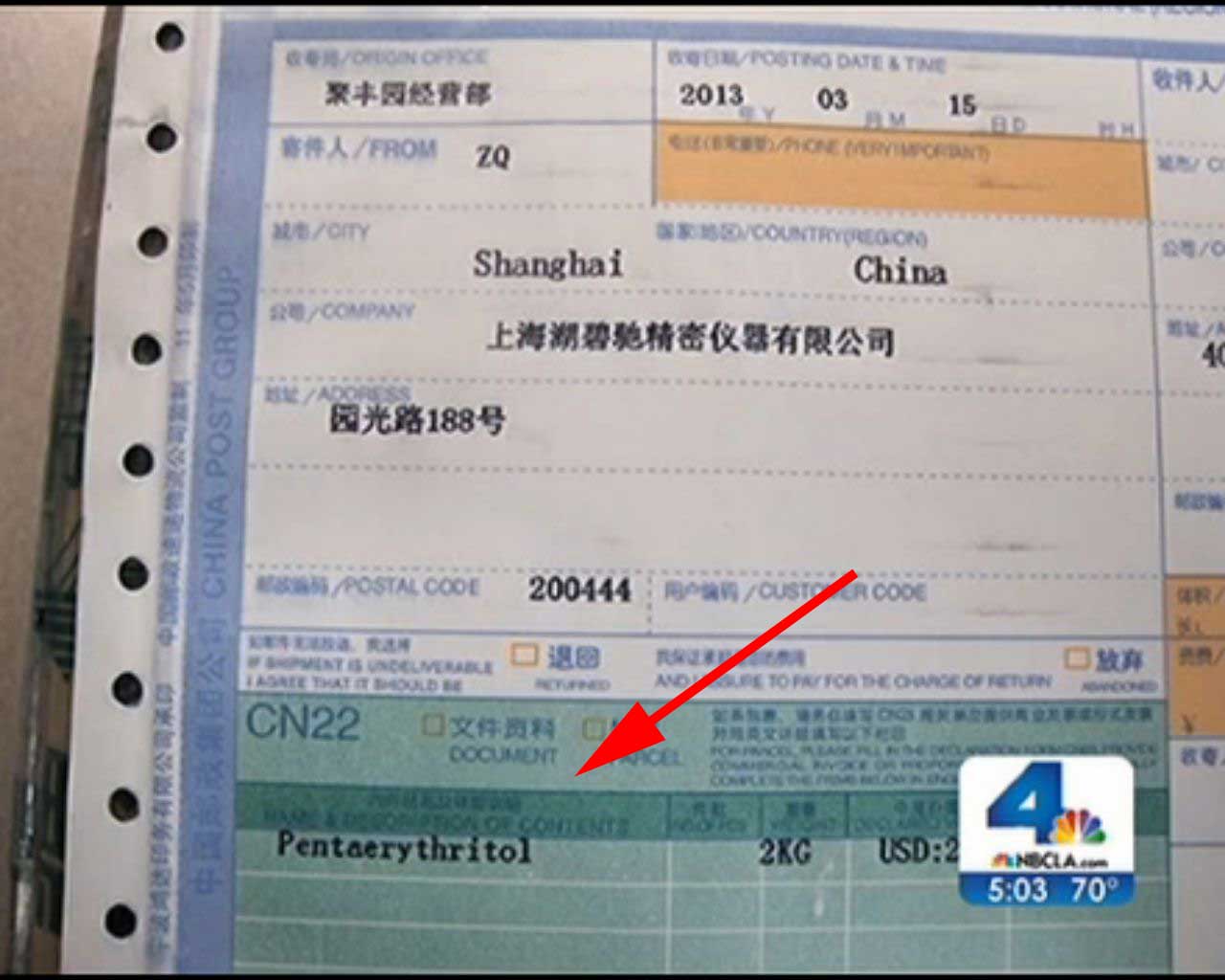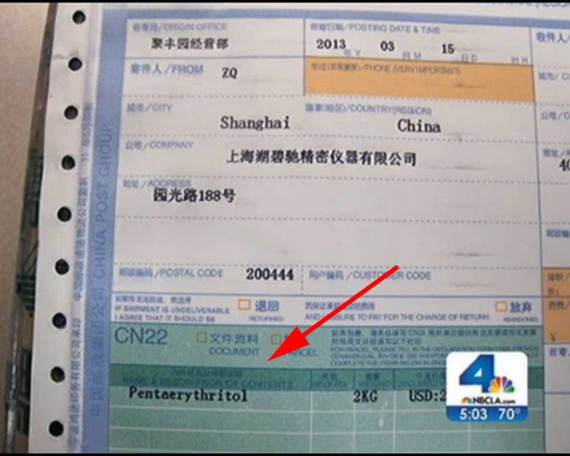
A California-based underground laboratory (UGL) was busted after its Chinese steroid powder source “ZQ” labeled a steroid package as containing two kilograms of pentaerythritol according to video provided by the NBC affiliate in Southern California. Pentaerythritol is a crucial building block of the highly explosive compound known as pentaerythritol tetranitrate (PETN). PETN is considered the “explosive of choice” among terrorists around the world.
Fortunately and unfortunately for Carlos Hernandez and Roxanne Hernandez, the package did not contain the main ingredients for the explosive. Instead, the powder tested positive for the presence of an unspecified anabolic steroid. The Hernandez’s were arrested for their involvement in an “apparent large-scale steroid distribution scheme” on April 8, 2013.
Since anabolic steroids are classified as controlled substances and importing them is highly illegal, sources usually intentionally mislabel steroid powder packages to avoid detection by U.S. Customs officials. Sources are known to use creative descriptions when declaring the contents of steroid packages e.g. “gay lube oil“. But pentaerythritol? Raising terrorism flags probably isn’t the best way to escape scrutiny by customs.
Pentaerythritol can easily be converted to PETN in simple, step-by-step instructions widely available on the internet. PETN, as the nitrate ester of pentaerythritol, only requires the availability of nitric acid to synthesize it from pentaerythritol.
PETN has uses in medicine as a treatment for angina pectoris. It is used pharmacologically as a coronary vasodilator similar to nitroglycerin. It is most commonly available in 10- and 50- milligram tablets and sold internationally under the brand names Duotrate, Pentylan, Peritrate and Pentalong.
An individual who orders two thousand grams of powdered pentaerythritol would not be ordering the chemical for therapeutic purposes. Such a shipment would likely arouse the suspicion of counter-terrorism authorities. After all, a bomb containing only 100-grams of PETN could destroy a car or blow a hole in the side of an airplane.
PETN has a long history of use by Al-Qaeda terrorists. Adding to the popularity among terrorists is the fact that PETN is practically undetectable by airport x-ray technology and “sniffer” dogs. PETN is also a component of “plastic explosives” such as Semtex.
“If you can lay your hands on a reliable source, [PETN] would be the explosive of choice,” said Hans Michels, an explosives expert at Imperial College, London.
December 22, 2001 – American Airlines flight 63, Paris to Miami: Al-Qaeda terrorist Richard Reid, the “shoe bomber”, was subdued by passengers before he could detonate a PETN-explosive hidden in his black high-top shoes.
December 25, 2009 – Northwest Airlines flight 253, Amsterdam to Detroit: Al-Qaeda terrorist Umar Farouk Abdulmutallab, known as the “underwear bomber”, unsuccessfully attempted to take the lives of 289 passengers and crew with a bomb containing PETN and TATP hidden in his underwear.
October 28, 2010 – UPS and FedEx cargo planes, Yemen to Chicago: Suspected Al-Qaeda operatives placed 300 to 400 grams of PETN inside of computer printer cartridges which were intended to be detonated by cell phone. The packages originated in Yemen and were destined for the United States. The packages were intercepted on cargo planes – one on a UPS plane at the East Midlands Airport in England and one on a FedEx plane at the Dubai International Airport in the United Arab Emirates (UAE) – after a tip from Saudi intelligence.
Airport security in the United States has been doing everything it can to target PETN in the aftermath of these attempted terrorist attacks. In fact, the implementation of full-body scanners was a direct response to the PETN bombing attempts.
Carlos and Roxanne Hernandez were arrested on various steroid charges by the Irvine Police Department in cooperation with special agents with U.S. Immigration and Customs Enforcement’s (ICE) Homeland Security Investigations (HSI).
The Irvine Police made no mention of pentaerythritol being listed on the package description or the role of pentaerythritol and PETN in terrorism. Nonetheless, local and federal officials seemed just as thrilled to have succeeded in protecting the American public from the “serious health threat” caused by the “powerful chemicals” and “dangerous substances” known as anabolic steroids.
There was no grave terrorist threat to be averted. However, the government may have stopped few bodybuilders from using steroids to build muscle.
“There is no higher priority than for us to remove dangerous drugs and illegal weapons from our community,” said Irvine Police Chief Dave Maggard. “We are grateful for the cooperative relationships we have with our partners at Homeland Security Investigations and U.S. Customs and Border Protection.”
“The underground production and sale of steroids poses a serious health threat,” said Claude Arnold, special agent in charge for HSI Los Angeles. “These are powerful chemicals under any circumstances, but the risks increase exponentially when you’re dealing with homemade counterfeits that are being taken without a doctor’s supervision.”
“One of Customs and Border Protection’s primary roles is intercepting anything that can harm the American public,” said Brian J. Humphrey, CBP director of field operations in San Francisco. “This operation is a prime example of how CBP, HSI and local law enforcement work in partnership to keep dangerous substances and their distributors off the streets.”
We should all be thankful for the efforts our government officials make to keep the American public safe from the threats of terrorism. But don’t forget how tirelessly they work to protect us from the muscle-building effects of anabolic steroids too!

About the author
Millard writes about anabolic steroids and performance enhancing drugs and their use and impact in sport and society. He discusses the medical and non-medical uses of anabolic-androgenic steroids while advocating a harm reduction approach to steroid education.

Leave a Reply
You must be logged in to post a comment.